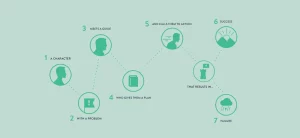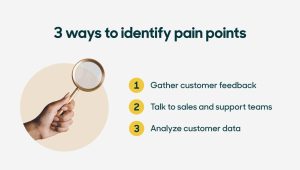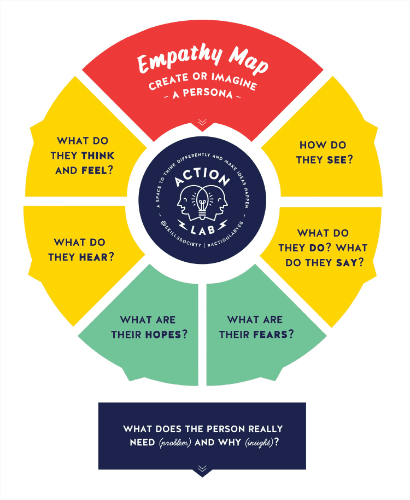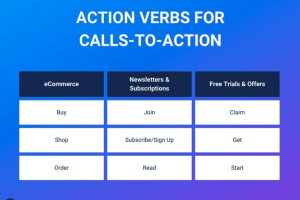How to Pinpoint Customer Pain Points With StoryBrand

You are the main character of your life.
Even if you aren’t a cape-wearing hero who battles bloodthirsty werewolves, you still face villains in your personal story: slow WiFi, rush hour traffic, parallel parking, faulty earbuds, the guy who cuts you in line when you wait for your morning coffee…. You name it.
From a marketing perspective, these villains are called customer pain points, otherwise known as problems that your target audience faces.
When you can clearly identify the pain points in your customers’ lives, you can connect with your customers better–resulting in more sales and stronger relationships.
How can you do this?
Simple: With good ‘ol fashion storytelling.
In this in-depth guide, we’re going to learn how to pinpoint your customers’ most infuriating problems, and discover how you can create irresistible solutions with the help of StoryBrand Framework.
Let’s dive in!
What Is a Pain Point?
A pain point is a persistent challenge or hardship that your customers face in their lives.

Ouch.
However, a pain point doesn’t have to mean physical pain (though, it can), but may also refer to…
- Emotional pain
- Feeling stressed, sad, stuck, etc.
- Financial pain
- Losing hard-earned money
- Productivity pain
- Never enough time in the day
- Logistical pain
- Lack of resources and tools to accomplish a task
Let’s look at some examples.
Customer Pain Point Examples
Once upon a time, in the land of office cubicles…. someone was sick and tired of not being able to stick their notes on a wall to read them.
Maybe they were fed up with wasting tape (logistical pain), losing important notes (emotional pain), or forgetting key tasks at work (productivity pain).
Enter: Sticky notes.
All it took was a piece of paper with a strip of sticky adhesive that didn’t leave residue and… POOF—a customer pain point has a solution.
Need another example?
Picking up after your dog is a necessary part of pet ownership–a pet peeve, if you will–but it’s also a pain point.
Did you know that there are companies you can pay to come to your house and regularly clean up all the smelly piles in your backyard?
Pain point: Customers don’t want to spend valuable time picking up after their furry friends.
Solution: A cleaning service that gives you precious time back in your day, and spares your nostrils (and shoes) from the stink.
Glamourous? Not so much.
Effective in solving a customer pain point? Definitely.
Why Are Customer Pain Points Important?
As we’ve seen in our two examples, customer pain points can vary.
The good news is that you don’t need to identify every customer pain point known to man–only your customers’ specific pain points.
But why?
Identifying customer pain points helps you learn exactly who your customers are.
If you don’t know who you’re trying to sell to, then you can’t create a clear message about your product or service, and you won’t be able to convince customers to spend their hard-earned money on your business.
Or worse–they may get confused about what you offer and switch to the dark side (your competitors).
Without clear messaging, you’re taking shots in the dark and hoping you hit the bullseye.
With clear messaging, you become a sharpshooter that never misses.

As a business owner or marketing strategist, it’s your job to clearly identify these pain points so that your business can effectively offer your customers valuable solutions to their problems.
Not only will this allow you to define your target audience, but will lead to more sales, stronger relationships, and happier customers that keep coming back for more.
And who doesn’t want to be happy?
The Secret to Understanding Your Customers: StoryBrand Framework
Remember when we said you were the main character in your own life?
Well, when it comes to your business, you need to take on a supporting role.
But don’t fret; even supporting actors can win Oscars.
Let us explain.
According to the StoryBrand Framework developed by Donald Miller, a great marketing strategy can happen once your business has a simplified, clear brand message.
To help businesses of all sizes effectively craft their brand message, Miller created the wildly successful 7-part StoryBrand Framework.
7 Parts of the StoryBrand Framework:

Image Source
Using basic storytelling principles you see in popular movies and books, this technique makes your customer the hero and you, the marketer or business owner, their guide.
Let’s take a closer look:
- Hero → Customer in need
- Hero has a problem → Customer’s pain point
- Hero meets a guide → Customer meets YOU (the business) who empathizes with them
- The guide gives the hero a plan → You give the customer a concise, clear plan to solve their problem based on the service/product your business offers.
- The guide calls the hero to take action → The customer follows the plan with your support, buying the service/product.
- The happy ending → Customer resolves their pain points thanks to your business, and is finally at peace.
With clear guidance and support that only your business can offer, you can help the hero (the customer) defeat the villain (their problems) and restore peace in their life.
Think about it:
Could Harry Potter have survived without Dumbledore? Luke Skywalker without Obi-Wan? How about Bilbo without Gandalf?
Highly unlikely.
That’s why it’s critical for you to position yourself as an irreplaceable guide to the customer.
Next up: Identifying the hero’s problem and gaining their trust.
How to Identify Customer Pain Points With StoryBrand Framework

Now that you’re a bit more familiar with the StoryBrand Framework, let’s dive into how you can use it to identify your customers’ pain points.
When it comes to problems, we’ve all got plenty.
The key to identifying customers’ pain points is finding specific problems that your business can offer high-value solutions to.
But how do you do this?
The StoryBrand Framework argues that every hero has 3 different types of problems, and it’s our job as the guide to identify them.
3 Types of Customer Pain Points
1. Physical (or external) problem – The actual challenge
- Question to ask: What is my customer’s problem?
- Example answer: The customer wants to lose weight.
2. Internal problem – How the hero feels about the challenge
- Question to ask: How does this problem make my customer feel?
- Example answer: The customer worries that they don’t have what it takes to lose weight.
3. Philosophical problem – overarching theme: good vs evil
- Questions to ask: Why is it wrong for my customer to feel this way? What do they need to have peace with this issue?
- Example answer: Healthy lifestyle vs. unhealthy lifestyle
Put yourself in your customers’ shoes, read reviews, conduct market research, and really dig deep to find their pain points.
Empathize & Connect With Your Customers

The next step is to show empathy and demonstrate authority.
In other words, your business will act as the trustworthy, wise guide the hero needs.
Show your customer that you not only understand their pain point but want to help them.
Show them that you’re highly qualified to help them solve their problem.
Too often businesses focus on the external problem (i.e., customer wants to lose weight) and forget to focus on the internal problem too (i.e., customer worries about failure).
They forget that empathy is one of the most effective storytelling tools and an effective way to connect with their customers.
Reassure your customer that they have what it takes.
Share your own personal weight loss journey.
Share success stories and reviews from past customers to get them to want to trust their time and money with you.
Ask yourself, what is your customers’ biggest worry? How can you solve it?
Become the Irreplaceable Guide, Offer Irresistible Solutions
Congratulations! You’ve clearly defined your hero’s problem and started to gain their trust.
Now what?
Next, you need to clearly and concisely communicate to your customers that you have a plan to help them save the day.
Create a Fail-Proof Plan
Say you own a weight loss clinic. Here’s what your plan might look like:
- Schedule a free phone consultation
- Come in to receive a customized weight loss plan
- Love the way you look and feel
See how losing weight doesn’t seem so intimidating anymore when it’s been broken down into easy-to-follow steps?
The key here is not to overwhelm the hero but to make them feel confident about taking action.
Take Action & Save the Day

Finally, you need to call your customer to action:
- Schedule now
- Register here
- Buy now
- Contact our team
Let the customer take back their life, gain time on the weekends with family, and overcome their pain point when they choose to purchase your product or service.
Once you’ve identified the pain points and the solutions you offer, incorporate them into your brand message.
Add your clear message to your company’s landing page, social media, and any other platform to start engaging customers.
Harness the Power of Storytelling with Chatter Buzz
Now that you know how to clearly identify your customer’s problems, it’s time to put the pen to the page and define your customers’ pain points using the StoryBrand Framework.
Experiencing writer’s block? Still not sure where to start?
At Chatter Buzz Media, our team of expert content strategists are seasoned storytellers trained in the StoryBrand Framework.
Let us help you create clear, concise messaging for your business that gets your customers clicking, buying, and coming back for more. Contact us to get started!








